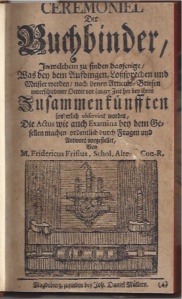Founder Tim James has been collecting bookbinding material for twenty years, but the initial hunt wasn’t always for a museum. He began the collection with the thought that upon retiring he could move up to the Gold Country, open a 19th century bookbindery, and become the town curmudgeon. Fortunately for us, he realized that this material and its history were slowly being lost and should instead be shared with as many people as possible.
Since then, The American Bookbinders Museum has received its nonprofit status, moved into a snazzy new location at 856 Folsom St. San Francisco, CA 94107, and is currently undergoing some incredible changes.
Back to the beginning, to the collection of these incredible pieces and beasts of equipment that thankfully have been saved for centuries. About half the equipment came from California, but there are others that traveled from the Midwest, East Coast, and as far off as Europe; the majority coming from other bookbinders. A few, such as the Imperial Arming Press, were found on ebay. This press was tucked away in the border region of France and Switzerland and found its way to San Francisco through both the Rotterdam and Panama Canal. This type of press is notorious for publishing books from the Swiss side of the border region that were forbidden in France. We like to think that our press would have applied titles to books that were meant to be smuggled into France and hidden from the censors.
In addition to equipment the museum has an extensive and ever-growing library and archive. The library boasts of over 3,000 books and periodicals, and we host a separate collection of bookbinding machinery manuals, booksellers’ catalogs, binders’ tickets, and more, in an archive measuring about 200 linear feet. Material hails from all over the bookbinding world with manuals in languages such as French, German, Spanish, Italian, Russian, Swedish, Dutch, and Japanese to name a few.
Cataloging is an ongoing process here, and recently we entered an undated (estimated circa 1700) German bookbinding text, quite possibly the oldest item we’ve come across. It’s full title is a bit of a doozy: Ceremoniel der Buchbinder, in welchem zu finden dasjenige / was bey dem Aufdingen, Lossprechen und Meister werden / nach denen Articuls-Briefen unterschiedener Oerter vor langer Zeit her ben ihren Zusammenkunfften sonderlich observiret worden, Die Actus wie auch Examina bey dem Gesellen machen ordentlich durch Fragen und Antwort vorgestellet by Friedrich Friese. The talented Peter Verheyen helped with a translation and in essence the book walks readers through the steps to becoming a proper bookbinder; from the rituals of the guild to the journey from apprenticeship to master.

Gems like this one make up these collections that span three centuries of bookbinding craft and history. The museum is made up of the artifacts that created books for the middle class. It illustrates the story of bookbinders in America: who they were, what they read, how they learned their trade, and how craft tradition and industrialization affected them. It is the goal of The American Bookbinders Museum to open its doors, library, and archive to bookbinders, museum patrons, scholars, and researchers. The archive will be cataloged with finding aids that will be accessible through the Online Archive of California. The database of scanned bookbinders’ tickets will also be available on the ABM website at a future, and much anticipated, date. As always, we will continue to acquire new materials, mainly through donors, to enhance our collections.
By Ally Power, Volunteer, The American Bookbinders Museum

